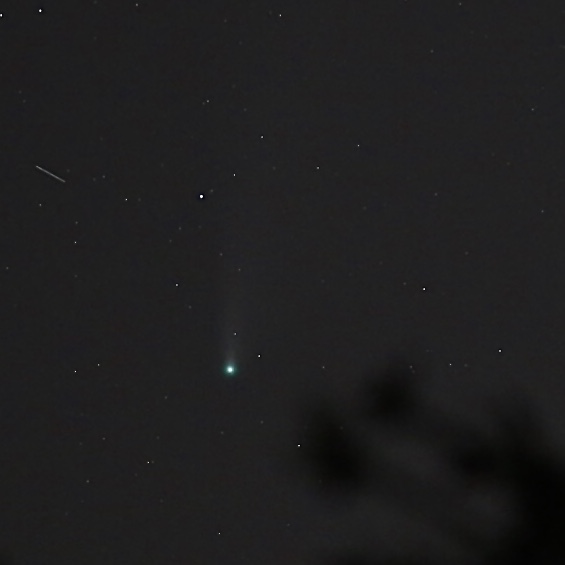
Credit: © National Maritime Museum, Greenwich, London.
As the green comet C/2022 E3 (ZTF) hurled towards Earth, media outlets bombarded readers with cheerful alerts. Anticipating its closest approach on Feb 1., a myriad of news with factoids was crushing down with a palpable sense of urgency. One title sums it up well: “The once-in-a-lifetime green comet threatens FOMO sufferers everywhere.” Historically, comets have provoked stirring emotions of dread and fear. The fear remains—although reincarnated under the cloak of celebration.
Before the green comet was turned into a black hole, Rivka Galchen’s essay [1] rescued me with its clarity. She skillfully weaves the discovery of this green comet into the fabric of history, recounts our evolving fascination with comets over time, as our understanding grew less fuzzy.
Historically, comets have provoked stirring emotions of dread and fear.
Comet C/2022 E3 (ZTF) last visited Earth about 50,000 years ago, when Homo sapiens, Neanderthals, and mastodons all roamed the land together. Once passed, we won’t see it again for another thousand-life-times—if it returns at all.
In fact, most comets are not return visitors in any meaningful sense to individual observers. Humans have a long history of fear toward comets due to their unpredictability—they don’t come back regularly as the Moon and stars do. As such, they were often seen as an omen [2] foreshadowing imminent doom.

The only comet visible by the naked eye that may revisit you in your lifetime is 1P/Halley [3], which has a period of approximately 76 years. It is named after Edmond Halley, who determined its periodicity using historical records and Newton’s method (also known as Newton-Raphson method). Halley died in 1742, sixteen years before the comet’s return. It came back in 1786, just as Halley had predicted
When Halley’s comet returned in 1986, the visibility was poor, as the comet and Earth were on the opposite sides of the Sun. It did not make it to the list of great comets (comets visible to naked eye). The viewing was further compromised by extensive light pollution from urbanization. Interplanetary spacecraft, though, got a good look at Halley’s comet that year as they flew past. Photos and data collected from the Giotto and Vega missions provided the first evidence that comets are in fact dirty snowballs. 2023 marks a significant year for Halley too, as it reaches its aphelion—the furthest point away from the Sun. In another 37 years, it will return to wow another generation of comet-watchers. I can hope to be among them.
Waiting for a comet like Halley may seem like a long game. Visits from comets, however, are not rare. The media hype fails to tell you that most comets are green; but they don’t look green to our naked eyes. Three years ago today, amidst the uncertainty of COVID-19 pandemic, I looked up the evening sky in my backyard and pointed my camera to an area just below the Big Dipper. Thanks to a near-dark sky with only a crescent moon, “seeing” NEOWISE, another bright long-period comet, was possible through my 200 mm lens and one-second exposure.

Galchen’s essay reminds us that comet discoveries are collaborations across generations of astronomers. Modern comet discoveries are collaborations practiced around the globe—among observatories, institutions, professional and amateur astronomers, and more recently, assisted by machine-learning algorithms. C/2022 E3 (ZTF) was discovered using the Zwicky Transient Facility (ZTF) [4], which takes images through Palomar Observatory’s forty-eight-inch telescope. To go through an astronomical number of continually collected images, machine-learning algorithms are called upon to help with detecting a moving object. Once found, observations from several observatories are pieced together to calculate the object’s orbit. From its orbit, the new comet can be traced to its origin and its nearest approach to Earth.
In February, when C/2022 E3 (ZTF) was at its closest, the night sky was brightly lit by a near-full moon—direct observation was impossible. I wasn’t disappointed, though, knowing that there will be another “long-haired” star [5] in a not-too-distant future.
Mark your calendars for early October 2024.
As C/2022 E3 (ZTF) was passing by us, C/2023 A3 (Tsuchinshan–ATLAS) was discovered—another comet from the Oort Cloud. If it travels as predicted, in a year or so, C/2023 A3 could be the next great comet, outshining 1997’s Hale-Bopp, which could set another generation of astronomers on their course.
References:
- Rivka Galchen (2023) “What the Green Comet Tells Us about the Past—and the Future.” The New Yorker. January 31, 2023. https://www.newyorker.com/science/elements/what-the-green-comet-tells-us-about-the-past-and-the-future
- Joel Schwarz (1997) “Humans Have Feared Comets, Other Celestial Phenomena Through The Ages.” https://www2.jpl.nasa.gov/comet/news59.html
- “1P/Halley.” https://solarsystem.nasa.gov/asteroids-comets-and-meteors/comets/1p-halley/in-depth/
- “Zwicky Transient Facility.” https://www.ztf.caltech.edu/
- The word comet comes from Greek komētēs: long-haired (star).
* Last update on July 27, 2023.

